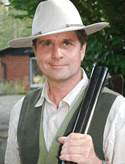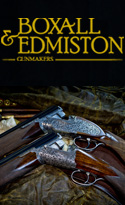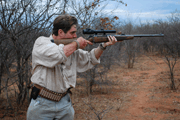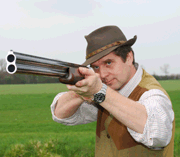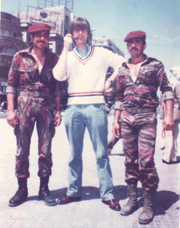Cartridges
The major components that make up shotgun cartridges are; shot, propellant, primer, wadding and case.
Shot: Spherical pellets which vary in size but which typically might number about 300 in a standard load (See table below)
Primer: Ignites the propellant and contains a small anvil within it and itself is partially contained in a 'battery cup' in centre of cartridge base
Propellant: a smokless compound today (once, it was black-powder). It generates in combustion gases which act on the piston like wad and the shot in front of it.
Wadding: Acts as a piston which pushes the shot out of cartridge body and down bore of barrel - it can be made of plastic (the most common today), fibre, or felt.
Case: the cylindrical - usually with a brass plated steel base - container for all of the above components
Imperial or metric conversion table
Payload equivalents for powder and shot
Ounces Grammes UK Shotsize Metric equivalents
13/16 23 AAA 5.2mm
7/8 24 BB 4.1
15/16 26 1 3.6
1 28 3 3.3
1 1/16 30 4 3.1
1 1/8 32 5 2.8
1 3/16 34 6 2.6
1 1/4 36 7 2.4
1 1/2 42 7 1/2 2.3
1 5/8 46 8 2.2
1 3/4 50 9 2.0
 What Cartridges You should Use
What Cartridges You should Use
Cartridges for training
I favour lightly loaded cartridges for instruction and training (I use them for just about everything). My favourite budget load is the excellent Express High Velocity. The Hull Chevron is another good choice and very soft recoiling.
Basic 24 gram (7/8th ounce) 12 bore loads will do far more than most shots realise. Shot size, might be 7 1/2, 8, or 9 - frankly it does not make much difference in the context of basic or intermediate level skeet or sporting or game shooting (stick to 7 1/2 or 8 for trap though). For 20 bores, I would choose 7/8th or 13/16th loads for beginners. Subsonic 20bores (as made by Hull) make an excellent training load for young shots.
Cartridges for clayshooting
My advice for novice to average clay shots is not to waste money on expensive cartridges. All the major manufacturers offer excellent 24 and 28 gram economy loads that will do the job very adequately. Look for clean burning powder, well formed cases with strongly attached rims, acceptable recoil, and, of course, good patterns from your gun/choke combination (i.e. even patterns without excessive gaps, excessive clustering, balling, or abnormal central concentration.) My favourite budget clay loads include Express’s High Velocity (a super load for 2 ½ chambered guns and anyone looking for quick but low recoiling load), the Express Procomp (a good, reasonably priced all-rounder for 70mm guns), the well priced Victory Sporter shell, Hull's Chevron High Velocity(they also do a ‘Low Recoil’ Chevron useful for beginners), Eley's First, Gamebore’s popular Clear Winner and Winchester Trap 100s.
Better clay shots may benefit from premium quality cartridge (but these will only be of significant advantage to top competitors, most notably, those involved in the international trap disciplines and FITASC sporting). Hard shot, with a high antimony content reduces pellet deformation and helps to produce even patterns, similarly, plated shot, as used in the most expensive cartridges, increases pellet hardness too, and appears to reduce central concentration. Express Excel Olympian (as used by Olympic Gold Medallist, Richard Faulds) and Supreme, Gamebore White Gold and White Gold F2, Hull Pro One (another personal favourite) and Sovereign, and Eley VIPs are all really excellent.
Sporting
For sporting shooting (except for the competitors in the top 10% of AA) I advise standardisation on a single pellet size - 7 1/2 (2.3mm)or 8 (2.2mm). Attempting to match cartridges to targets, like changing chokes from stand to stand, only serves to distract. For those who insist on changing cartridges, 9(2mm) shot may, generally, be selected for close targets and medium range targets where the belly is presented to the shooter (but avoid it for hard composition targets such as rabbits or on very windy days because it is prone to drift), for, everything else, and especially edge on targets at range, use 7 1/2 shot.
Skeet
Skeet shots do not have as many choices to make, nearly all U.K. shots use 9 shot in a 24 or 28 gramme load (Olympic Skeet shots may only use the former). I can see no advantage to using smaller or larger shot, or larger payloads, even if the rules permit it. Velocity, within reasonable limits, is not a great concern for skeet shooting, comfort is of paramount importance.
Trap
As for trap shots, some prefer to use 8 shot in the first barrel, but use a larger size 7 1/2 or 7 (2.4mm) in the second barrel, because the bigger pellet retains kinetic energy better at range. Again, I tend to think this is a distraction. My own preference would be for 7 1/2 shot in both barrels in a fast 24 gram load. Although cartridge quality and velocity are more important considerations at trap than any other discipline, one must have confidence in the cartridge above all else. Trap shooting is a game of confidence, lack of it will destroy your timing.
Cartridges for game shooting
For formal driven shooting. I would recommend 1 or 1 1/16 ounce 12 bore loads for pheasant at modest to medium ranges. Ideal shot size would be 6 or 7, although some people feel more confident with 5 shot. For really high birds, such as those sometimes seen in the West Country, I would prefer a slightly bigger payload: 1 1/8oz. or even 1 1/4oz. My favourite 20 bore load for pheasant is 1 ounce of 7 shot in a 2 3/4" (70mm) case. Most people find recoil less of a problem when game shooting because of the adrenaline factor and may therefore choose a high performance cartridge without ill effect (although I tend to use inexpensive cartridges by choice for clay shooting, I usually advocate buying a premium cartridge for game). If recoil is a problem, do not despair, modern light game loads are very efficient. I would always recommend using cartridges with a low bar figure in older guns.
Recommended pellet sizes (lead unless stated) for game shooting
Decoying pigeon: 6 or 7.
Snipe: 7 1/2, 8.
Woodcock: 6, 7
Partridge: 6, 7
Duck (foreshore): 4 (long range, bismuth and tungsten), 5 (bismuth and tungsten), 3 or 4 (steel and tin)
Duck (flighting inland): 5 or 6 (bismuth and tungsten), 4 or 5 (steel and tin)
Rabbits: 5 or 6
Hares: 4 or 5
Non-toxic
It is now mandatory that you use non-toxic cartridges over wetlands and 300 or so sites of Special Scientific Interest. There are various products on offer:- tungsten polymers, tungsten iron, bismuth, tin and steel are the main contenders. Tungsten based shot shells such as Tungsten Matrix from Gamebore and Hevishot from Express perform exceedingly well (sometimes better than lead) in modern guns but are very pricey. Bismuth, marketed by Eley, is a metal much like lead save for toxicity. It also performs very well and may be obtained with a felt wad if required. Cost is much more than lead. Steel and tin (now going out of fashion) are lighter than lead and reduce the range at which birds may be shot. Because they are fast out of the muzzle they also reduce the minimum range. Their window of opportunity is about 20-35 yards – stay within that zone and you will bring the ducks down effectively. Steel is the cheapest of all the alternatives and will probably be the main alternative to lead in the future. It is also suitable for clay shooting, but I find the felt recoil signature sharper than with conventional cartridges – nevertheless someone has already managed to shoot 600 straight (no error) in a skeet competition.
Detailed Information on the Components of a Shotgun Cartridge
Shot
Modern shot is not made from pure lead, rather the lead is alloyed with antimony (1 - 8%) for hardness and small quantities of other substances may be added to the mix. Some high performance cartridges use plated shot. This hardens shot even more and reduces friction between pellets - thus easing the passage of the shot down the bore and through the chokes. Shot may be lubricated with graphite to further reduce friction.
Alternatives to traditional lead shot include bismuth and tungsten polymer. Both offer similar ballistic properties to lead, but with reduced toxicity. Other alternatives to lead include soft iron (commonly called steel), tin and zinc.
Propellant
Modern smokeless propellants fall into two broad types: single and double base. Both have their advocates: single base powders tend to be cleaner burning and may cause marginally less barrel erosion, double base powders are hotter burning and have a slightly greater muzzle flash.
Most modern powders are of the 'progressive' type, which means that they release the majority of their energy after achieving peak pressure. This means that modern cartridges, especially those with heavy payloads, can be made with relatively low operating pressures.
Primers
Priming compounds in ammunition were once highly corrosive, being based on mercury. Modern primers are chemically stable, sensitive to impact (but not too sensitive), non-corrosive, yet provide more reliable and controllable ignition.
Wadding
The wadding in modern cartridges varies greatly. It is not simply a question of it being made of plastic or felt. Cartridges may have felt or cellulose fibre wads (the most popular non-plastic type, but not quite as efficient as felt). Felt or fibre wads may be combined with a simple over powder disc of card or with a more sophisticated, skirted, obdurator of card or plastic to make them more efficient. Any over powder disc prevents the powder burning out the main wad, a skirted card disc or plastic obdurator greatly improves sealing too.
Similarly, there are many different types of plastic cup wad with different styles of skirt, column and cup. Plastic cup wads have two great advantages, they simplify loading for the manufacturer and protect the pellets as they pass through the chamber forcing cone and the choke area, reducing the number of flyers, and shortening shot string length. Plastic wads are normally associated with slightly tighter patterns for these reasons.
Cases
Although paper cases are still in use, most modern cartridge cases have a body made of plastic. The case construction is an important aspect of cartridge design and significantly affects the performance of the cartridge. There are four main types of plastic case, and the most common, and cheapest to make, is the Parallel Tube. It consists of a polyethylene extruded tube, a plastic or paper base wad and a metal base.
The more expensive Compression Formed case has tube and base made from a single slug of plastic with a metal base attached. It is very strong, easy to crimp, and produces slightly higher pressures than the Parallel Tube type.
The ACTIV case, which appears to be all plastic, actually incorporates a metal reinforcing ring moulded into the base, and the new Gordon case has a combined metal and plastic base.


